
January 22, 2024
Caps Are A Part of But Not the Answer to Fixing Canada’s International Student Program!
In my most recent blog, “The Ultimate Direction of the International Study Permit Program Is Inevitable. The Critical Question is, How Quickly Can Immigration, Refugees, and Citizenship Canada Get There?” I continued to advocate for an Expression of Interest (EOI) model to respond to many of the challenges the program currently faces. Today, Immigration, Refugees and Citizenship Canada (IRCC) imposed significant limitations on international students and the International Study Program (ISP).[1] The opinions on the changes range from a necessary and welcome correction to a kneecapping of the ISP.
The limited details available so far include a temporary cap on study visas for 2024, leading to a 35% decrease from 2023, and affects approximately 360,000 approved study permits. Provincial and territorial caps, weighted by population, IRCC argues, will result in notable reductions in areas with unsustainable international student growth. The new requirement for an attestation letter from provinces or territories for certain study permit applications commencing January 22, 2024, is somewhat vague and seems to download the issue on provincial and territorial governments.
Furthermore, eligibility changes to the Post Graduation Work Permit (PGWP) starting September 2024 exclude students in curriculum licensing arrangements, impacting their ability to transition to permanent residency. Additional measures include forthcoming details on open work permits limited to spouses of international students in master’s and doctoral programs, or professional programs, excluding all those in other study levels.
We will learn more in coming days but at first glance the changes seem disjointed and uneven. A number of questions arise including:
- Who was consulted on these proposed changes?
- In particular, were applicants and applicant representatives consulted?
- Are provinces and territories prepared for these changes?
- Were they consulted?
- Is the pending inventory at visa offices and at the Federal Court where applications may be sent back for redetermination subject to the reduction and resulting limitations?
- Will the 35% reduction be targeted at the number of study permits approved or application intake?
- Will applications that are not accepted be terminated?
- Or will there be a pool of applicants?
- Will the ISP operate on a first come first serve basis until the cap is met, like we have experienced in other categories where programs close in minutes?
- Will applications be streamed differently based on intended destination?
- Upon what evidentiary basis were the distinctions drawn as to which applicants would benefit from post-graduate work permit and dependent work permits? It appears arbitrary.
- Do we aim to attract more university based applications or in any educational streams like the trades going forward?
- What is the focus of the ISP going forward as it relates to our domestic goals and international obligations?
- Why were these changes preferred over other options presented to IRCC, including an expression of interest (EOI) platform that was more nuanced?
- What happens after forty-eight months?
I have stated in many forums I am a proponent of caps but in addition to varied temporary and permanent resident streams with clearly established and well communicated eligibility criteria, targets and processing times. The mode of delivery is essential. Seemingly arbitrary distinctions are extremely problematic. Different streams is an excellent approach, but a reasonable argument cannot be made that certain university students should benefit from accompanying family support while other students cannot as just one example.
Two-Stage EOI and Invitation to Apply (ITA) Selection Program
In the EOI model, all applicants would file an EOI in various and expanded student categories. Consideration should be given to new streams which could include:
- Nimble and flexible study permit pathway for in-demand occupations;
- Distinctions between College and University Streams – not based solely on disincentives but on our domestic and international needs and obligations;
- Provincial and Municipal Study Permit Stream – more direct involvement of distinct levels beyond a vague attestation letter process for only certain applicants; and
- Humanitarian Study permits.
Points would be allocated based on factors depending on the category, educational history, previous degrees, grades, language ability, financial sufficiency, in-demand streams, educational institution, etc. ITAs would be issued to students based upon streams, caps, and other factors.
Applicants not selected for the school year would terminate and thus no backlog. Not just a reduction as we see with today’s announcement, but a complete restructuring of inventory tied to evidence-based and real-time needs. Where students across different steams will be incentivized to apply based on clearly articulated targets, needs, streams and outcomes (permanent resident pathways versus non-permanent resident pathways).
Educational institutions would receive points based upon a few factors that might include labour market outcomes, admission integrity, number of foreign students, mental health, and other supports for international students, etc. A new EOI/ITA ISP program would serve to ensure proper intake, eliminate abuse where possible, and control inventory which I am not convinced these changes will – aside from deterring certain students from applying.
Tinkering at the edges will not take us where we need to go beyond public platitudes from certain sectors and a shiny new number (35% reduction) around which we will now define the ISP. IRCC should engage in broad based consultation and work towards expanded study permit categories for applicants reflective of the varied reasons for short and long-term study and/or permanent migration bolstered by effective public messaging of the ISP to better manage all stakeholder expectations and limit discrimination. All keys to a new, modernized and holistic ISP, which is what Canadians need for our future. Unfortunately, we are still waiting.
To be continued.
